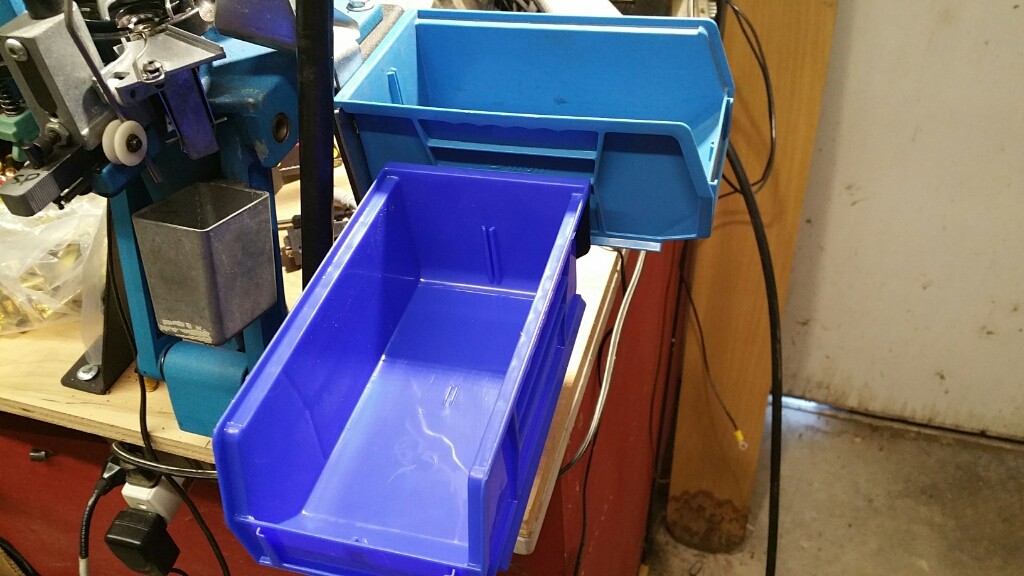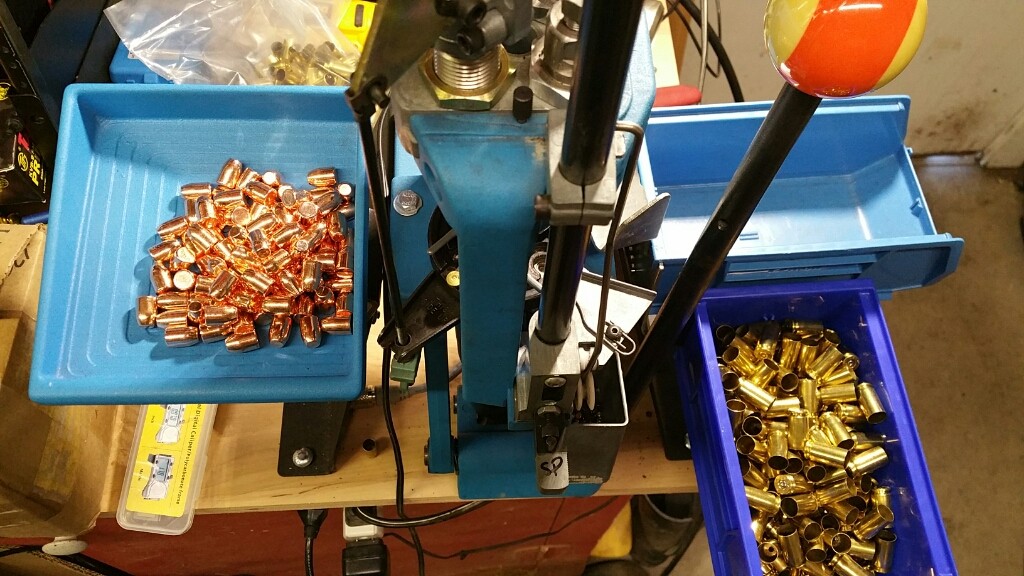Well, the extra bins definitely helped speed up production!
 The color difference is fairly apparent here. The bin in the foreground is the Akro-Mills native bin, the background is the Dillon version.
The color difference is fairly apparent here. The bin in the foreground is the Akro-Mills native bin, the background is the Dillon version.
 This arrangement with empty brass within easy reach definitely sped up the loading rate. I was able to get well over 150 rounds loaded in a little more than an hour, including some troubleshooting as detailed below. My QA fail rate is about the same, with most rounds dropping unrestricted into my gauge block, a few fitting well enough to probably work in the pistol, but I rejected them to the rework bin (since I now have enough bins to have a rework bin) and a couple that wouldn’t go in well at all. Historically, I can usually get most of those those back with the Bulge Buster, but it is not currently mounted on the bench.
This arrangement with empty brass within easy reach definitely sped up the loading rate. I was able to get well over 150 rounds loaded in a little more than an hour, including some troubleshooting as detailed below. My QA fail rate is about the same, with most rounds dropping unrestricted into my gauge block, a few fitting well enough to probably work in the pistol, but I rejected them to the rework bin (since I now have enough bins to have a rework bin) and a couple that wouldn’t go in well at all. Historically, I can usually get most of those those back with the Bulge Buster, but it is not currently mounted on the bench.
I had two or three rounds where the bullet seating went badly. I probably need just a tiny bit more flare in the case mouth to address that. I set it intentionally close to help keep from overworking the brass, so I have some adjustment range. Cartridge OAL was well maintained in spot checks, 1.125″ to 1.130″ with most checked units at 1.127″.
The biggest problem was with primer feeding, mostly due to the spent primer catcher chute not pivoting freely on it’s somewhat damaged cotter pin. This chute is gravity operated. The down stroke of the ram opens the chute to allow the spent primer to fall out, but the chute would bind on the pin and not fall closed on the upstroke. The spent primer would fall into the works, frequently landing where it would prevent the slide assembly from returning forward to align the new primer with the shell plate. I reworked the pin a couple of times before I got the chute working reliably. I will add that pin to the list of minor parts I’d like to order from Dillon.
That left a much simpler issue wherein the slide itself needed cleaning and lubrication. Normally, the slide is operated by a carefully formed steel wire rod and rollers that push the slide out to pick up a new primer at the top of the upstroke. A spring pulls the slide back in, against the rollers and rod on the downstroke. It would on some occasions, snag for a fraction of a second and when the spring would overcome the friction, the slide would move suddenly, often unseating the primer from the punch assembly. This primer would most often land in the works somewhere, either stopping the slide from going all the way home, or landing where it would interfere with the shell plate platform. If by a some miracle of chaotic physics it landed clear of the works, then there was obviously no primer for the next case.
In the course of looking up the proper part names above, I did finally find the Dillon bins, for $2.95 each. 🙂